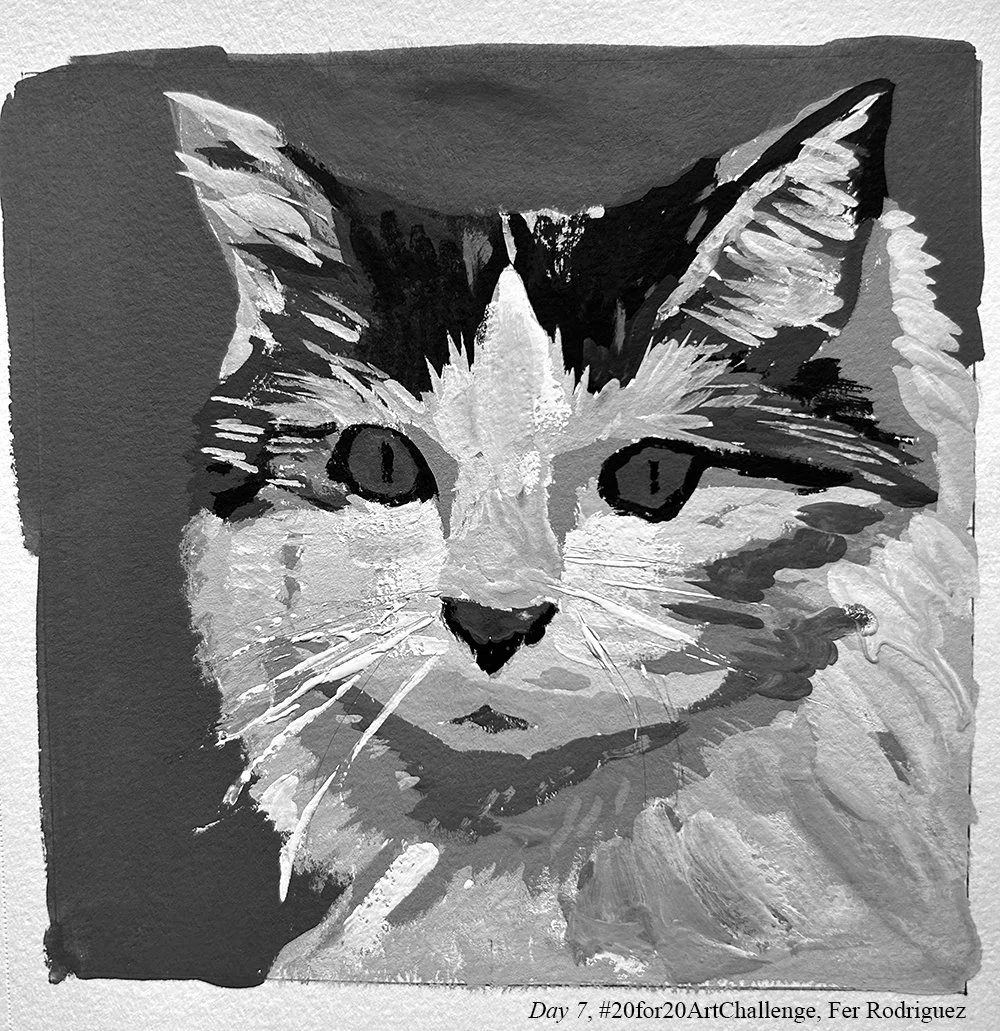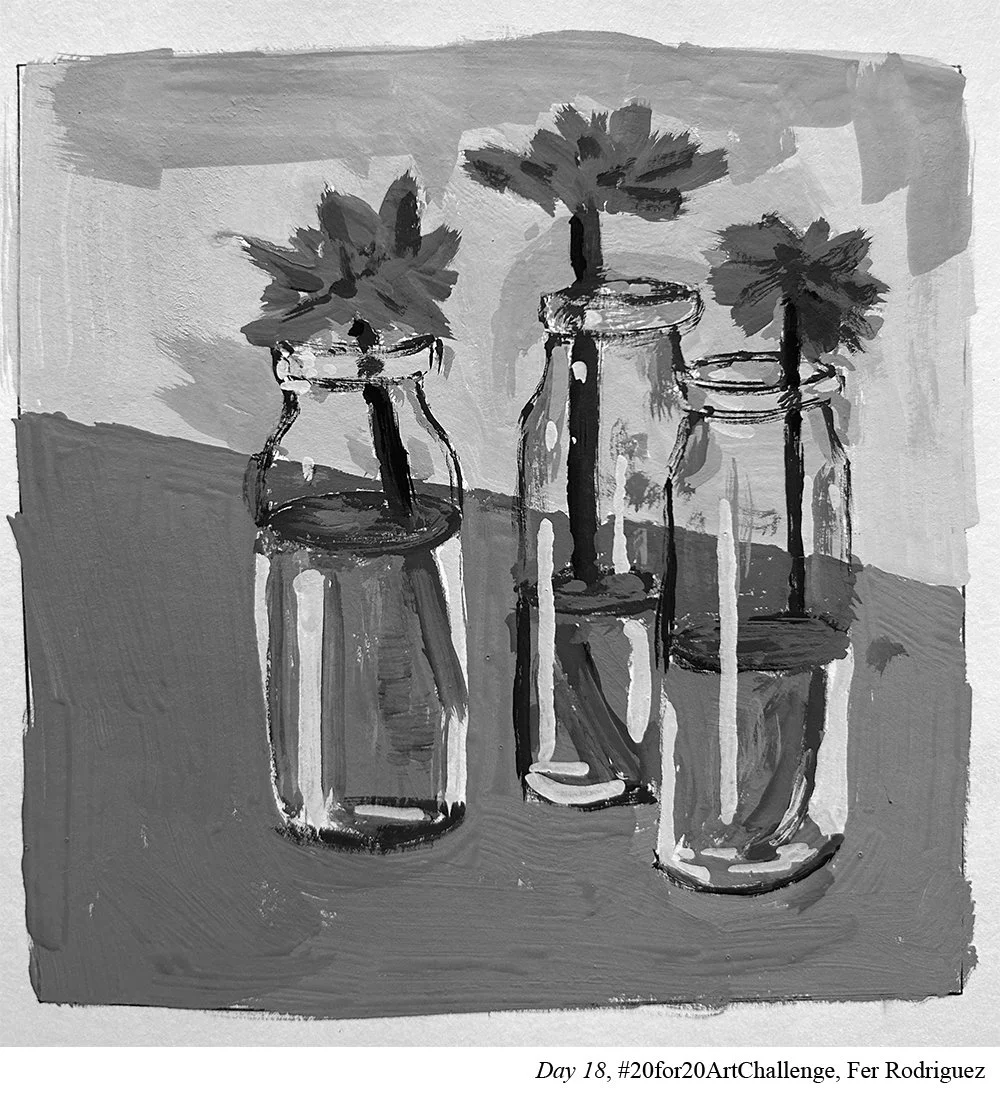#20for20 Artist Spotlight: Fer Rodriguez
Fer Rodriguez walked into the Challenge already a consistent painter. But the #20for20ArtChallenge gave him a framework to try a new medium and discover some surprising ideas along the way. You can learn more about Fer Rodriguez on Instagram or at his website.
How long did you work each day? (20 minutes max or 20 minutes min or some combo). What did that way of working give you?
I set my max at 30 minutes. The time limit gave me a strong focus while painting -as I have a “deadline”- and also helped me a lot to stop overworking, something that I tend to do often.
How did you decide where in your day to put your 20? What kinds of things were you considering when planning that schedule?
I scheduled it in the morning for most days, as is the time I’m fresh, full of energy and with the right mindset. Some days this is not possible, and for those days I have a slot scheduled right after work and before dinner.
To me it was important to do the 30 minutes all at once, rather than splitting it, for example, into two 15 minutes or things like that. The 30 minutes was just painting, without some additional steps I did before and after the painting (I’ll explain this later).
When it’s just 20 minutes, there's a risk in expanding out the time until you’ve “finished a painting” or got something you like enough to share with the world. What is the benefit to you to really hold to the 20 minutes?
The one rule I had set for myself that I was not going to break was the 30 minute max.
As you mentioned we typically we paint “until it’s finished” or it’s “instagramable”, but now you need to change that approach into whatever you get at 20 or 30 minutes. Is a significant shift, and I suggest you do be honest with yourself and commit to do it regardless of the outcome.
You commit to the max time and you commit to share.
You make the hard decisions before you start the painting so that later there are no emotions playing tricks on you. (That’s why stock traders have rules predefined before they enter their trades…they can’t get carried away by the whims of the markets or their emotions...).
For me, after setting these rules to myself, it was not difficult. Whether I liked it or not, whether it was a masterpiece or a rough sketch full of errors, it did not matter.
What this taught me is that you can absolutely learn a lot by painting small amounts of time. It’s so powerful that it does not seem to be real.
Before the Challenge even started you walked in with a plan and then it changed. Could you talk about how it changed and why you changed it?
My plan was to try a new medium gouache. As I did 2 sketches I realized how different it was from oil (my regular medium). Then I saw a post you shared about another person who took the Challenge to focus just on values, with black and white. I immediately thought that was perfect for me: I could still try a new medium while learning and strengthening my value understanding.
As the Challenge progressed I was tempted to revert back to color -seeing everybody else painting beautiful colorful things was teasing for me- but I stuck to my plan and kept it to black and white, and I don’t regret it at all!
How much was it helpful to audition your original idea BEFORE the Challenge even officially started? Why?
It was critical because it was a good idea but it needed some fine tuning. That fine tuning allowed me to be successful throughout the Challenge as I knew what the next day would bring and how I should act upon it.
You came in with a background in oil but decided to focus on a new medium gouache. Even though you came in with a bunch of experience, how was it beneficial to approach a new medium in a super simplified way by focusing on value work in black and white paintings?
It was really great because despite some initial obstacles I ran into the new medium (fast drying, getting darker when dried) the underlying value study could be easily extrapolated to other mediums (oil in my case).
The benefit was straightforward because value studies are something you can carry from medium to medium and really, you need no matter what you do.
I also got additional benefits, as in order to work on values while under the clock, I needed to work on composition & simplification (what goes in but most importantly what I take out): No matter what medium you use, you have to work on these regardless and they are 100% portable and useful.
You painted in black and white each day, focusing on value. Did you jump right into the piece or did you do any thinking before you began?
My process consisted of 4 steps.
(1) Decide the format of the painting and draw a light simple sketch
(2) Before starting painting, take about 5’ to analyze the picture and come up with an upfront plan on how I am going to divide the picture into large masses and assign a value to those masses beforehand. In this step, I may add/remove things from the sketch and do other adjustments I see fit.
(3) Now the painting begins and here’s where my 30’ started. I divided it into two parts: 25’ for painting (then alarm sounds to let me know there are 5’ left) and the last 5’ for any adjustments I needed to do. If I want to add details and ornaments to a portion of the painting but I see a big mistake or an area underdone, then I know 5’ is not enough for everything, therefore I know where I need to focus.
(4) And lastly, once the painting was finished, let it dry and about 1 hour later take a picture and with fresh eyes do a small retrospective-like approach.
In the Challenge, each day you thought (and shared) about what you liked in a painting and what you didn’t like? What benefits did you feel by giving some thinking time to each day’s efforts?
What I did was the Japanese concept of Hansei; the ultimate goal of Hansei is growth through honest self-evaluation, which builds better habits and systems over time.
This is extremely crucial and I can’t stress enough its importance. It's really what helps us get better, by objectively analyzing our work, pat ourselves on the back for what we did right and gently acknowledge where we could’ve done better.
This is setting you up for success for the next one as you are reminding your future you the problem you had in this painting, how you solved it or how you would have solved it.
In my case it was: (1) What did I like about the painting? (2) What did I not like about it? I would handwrite notes in the same paper where I painted to remind me of things I need to consider next time.
So often the focus is on finished and beautiful work. Did you feel any difference in shifting the focus to the showing up? (The habit.) How did that change your relationship to your practice?
Most definitely.
Showing up has not been an issue for myself, as I’ve been pretty consistent the last few years.
However, focusing on unfinished / sketchy work was very interesting because it reduced the “anxiety” of performing and having a nice painting at the end of it. Instead, I felt I painted super loose and relaxed (even the clock was ticking). I read somewhere that we should be painting like kids, as kids typically are playful, joyful to the point where they are unaware of the surroundings and of what “could happen.” This is why they are creative, absolutely not afraid to try new things even if they are ridiculous. Everything is fine and fun: it is pure experimentation.
I felt like a kid during the Challenge!
Any days jump out as having aha moments? Could you share what those were?
I had many, but I would highlight the following:
1. Particularly in landscape painting, it is not about copying but rather translating. So don't be afraid to add, remove or move around things as you please, as you need, as you see fit. When in doubt, REMOVE. This happened throughout the Challenge, but particularly on day #10 with the desert, that was a bit overwhelming at first glance.
2. Also when in doubt about values: sky is the lightest, ground follows, mountains and things in the distance and lastly vertical objects the darkest. Start here and then adjust as per the reference. Many reference pictures do not necessarily show this, but if you follow that recipe you are out for a good start.
3. Spend 5 minutes planning your value map. It's so worth it. If there’s only ONE concrete actionable item from this blog post to remember…is this one.
4. Incredible insightful work can be done in less than 30'. Great aha moment throughout the Challenge.
5. Avoid using pure white or pure black. A tiny tad of the opposite makes a HUGE difference in portraying the extremes of the spectrum.I did not follow this in 2 paintings and I regret, because those values seem out of tune.
6. Last and most importantly: Allow yourself to fail, even if miserably. The Challenge allowed me to fail and gave me another opportunity the next day to get better. Ups and downs, but the long term trend is UPWARDS.
What was the most helpful mindset for you to try and keep during the 20for20? Was there anything that was useful to remind yourself as you showed up each day? What was that and why?
I jealously guarded my time and made sacrifices some days (did not do other things I had to) to prioritize at all costs my practice. Becoming better is one of my goals and I needed to be consistently trying and showing up every day. Like anything else may feel weird the first few times you do it but then it is automatic and it just simply happens without even noticing.
Any advice to someone jumping into the Challenge for the first time?
Please do so! For some reason we are pretty bad at allowing ourselves to practice. We think every painting should be hung at the Louvre and the reality is that even the great masters made thousands of mistakes…so why can’t you allow yourself to make a few?
The Challenge allowed me to loosely explore my understanding of values, simplification, composition and much more. Needless to say, all the invaluable feedback (and ideas) you get from the other participants as all of us have different views of the same pictures. I have not seen two identical paintings! There’s so much richness in that that you can’t even start measuring it. I personally have about a 70-30 ratio of “conformity”. I liked about 70% of what I did, I did not like about 30%. That 30% is my bucket list / north star to keep improving. It would’ve probably taken me months if not years to discover all those. With the Challenge, I discovered them in less than 3 weeks.
If you would like to join the next #20for20 Art Challenge, learn more here.









